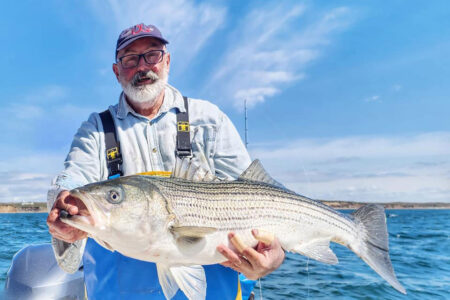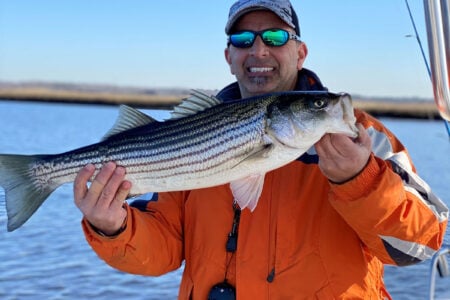
Tips from pros like Mike Iaconelli for applying freshwater techniques to striped bass fishing.
Freshwater bass fishermen are a different breed. They seem to find a way to make everything super-technical; this is because they make or break or their livelihood by winning tournaments. Any angler who has watched tournament bass fishing on TV or YouTube is familiar with Mike “Ike” Iaconelli and knows that he is a passionate and excitable fisherman that has the skills and the track record to back it up. I was very lucky to have the opportunity to take Ike striper fishing a few times thanks to an introduction through a mutual contact. And it was a really eye-opening experience watching him apply his freshwater bass tactics to stripers in the salt.
From winter holdovers in December to summer trips on Long Island Sound, Ike always seemed to have some novel idea from freshwater fishing that he was sure would work for the striped cousins of his beloved largemouth and smallmouth bass. And he was usually able to make it work.
Drop The Blade
Our most recent trip was actually a December run for holdover stripers. During the cold months, striped bass often stack up in dense schools that can be tens-of-feet thick. My go-to lure for this situation is the 5-3/4-inch Fin-S fish rigged on a half-ounce Lunker City Titan HD leadhead. It’s hard to beat the success rate of this tried-and-true striper lure but I did watch Ike do very well using some methods that are popular in the freshwater bass world.

The lure that worked best for Ike was a blade bait. And as a matter of fact, I fished with another well-known tournament guy who also did well tossing a blade bait for stripers a few years back. For those who don’t know what a blade bait is, it’s kind of cross between a Rat-L-Trap and a jigging spoon. The bait is metal and – sort of – wing-shaped. There is a weight placed at the natural balance point of the lure and the line tie is positioned directly above that (there are often multiple tie locations that can achieve slightly different actions). They can be cast or jigged, but in either case, you want to keep it near the bottom as you hop it along. Experiment with subtle and aggressive lifts of the rod, to find out what the fish want.
The average depth we were fishing was 15 to 20 feet with light current and wind. Ike was fishing a 3/4-ounce Molix blade bait in pearl white which was perfect for this scenario as it cuts the water well, he let it sink to the bottom followed by aggressive upward rod snaps and letting it sink back to the bottom. I could also see this working well on windy days because it would be easier to stay in contact and feel the strike. The lure comes rigged with two double hooks instead of trebles, allowing the lure to touch bottom with a lower chance of hanging up. Ike also noted that you will get some bonus catches because of the double hooks you will hook fish that swipe at the lure that otherwise would have been a missed strike with a single hook lure.
And while Ike was scoring well in the winter, it should be noted that it would be a good idea to try a blade bait in any situation where stripers are tightly schooled. And, with a little searching, you can find much larger blade baits online. And I probably should add that a Rat-L-Trap is also an effective lure for stripers that gives off great noise/vibration and is the spitting image of a peanut bunker.
Believe The Chatter

Another lure that Ike fished was a chatterbait. I had never seen one before, but this lure has a lot of potential for stripers. A chatterbait is sort of a mix of a lot of different things; it’s part jig, part spinnerbait, part swimbait and partially new and different. Basically, it’s jighead with a free-moving, five-sided metal plate connected to the eye of the jighead; the line tie is positioned toward the center of the metal plate. Behind the jighead you might find a rubber skirt or you might find a swimbait hook for attaching various trailers. When the lure is retrieved, the metal plate rapidly vibrates, creating its signature ‘chattering’ sound.
Chatterbaits have become very popular in freshwater fishing over the last several years and, as with most things in fishing these days, they have been adapted and super-sized for other types of fishing. Smaller, freshwater bass, sized versions are tough enough for stripers up to at least 20 pounds. But, with a little snooping around on some of the musky websites, you’ll find much larger chatterbaits that will certainly be up to the task of tackling trophy linesiders.
Ike fished his with a large paddletail swimbait threaded onto the hook and the baits did well swimming through rips and I’m sure they would catch well cast into boulder fields or along jetties as well.
Crossover Classics
It’s impossible to ignore the fact that many of our classic lures originated in freshwater fishing. When I was a kid in the 90s, the “sassy shad” was the hot ticket for schoolies followed by the Lunker City Salt Shaker (which works great fished off a three-way rig in deep water and heavy current). About a decade ago, the Keitech swimbait became popular among Northeast striper fishermen. Not only does its ribbed body give the bait a wider appearance with accentuated action, but I believe it gives off more vibration and displaces more water, giving stripers something to hone in on. Today there are dozens (maybe hundreds) of brands of soft plastic swimbaits and most of them work very well on stripers.
For stripers, soft plastics are typically rigged on a leadhead but freshwater bass fishermen rig them on a large swimbait style hook either unweighted or with a keel weight on the hook shank. One of the advantages to this set up is that the lure sheds weeds and snags a lot less and you can “skin-hook” the hook point (which just means to stick the hook point back into bait making it less likely to pick up weed). Swim baits come in a variety of sizes, but most striped bass anglers prefer paddletails in the 5- to 7-inch range.
Striper fishermen have been reluctant to adopt the swimbait hook; many say that they feel like they miss too many strikes with ‘Texas rigged’ plastics. Because striper fishermen throw so many baits with trebles or fully-exposed single hooks, a firm and immediate hookset is not usually required, if you can train yourself to set the hook firmly whenever using a soft plastic rigged on a swimbait hook, you’ll quickly see the value of these hooks and the nearly-weightless rigging options they open up to striper fishermen. In fact a BKK Titanrider or Owner Beast Hook is a great choice for another freshwater crossover bait that works wonders for stripers, the Slug-Go (sizes ranging from 7 to 12 inches).

Classics In The Making?
By now most striper anglers have heard of the Nichol’s Ben Parker flutter spoon. This lure has exploded in popularity over the past few years, but it has actually been around much longer as it was originally designed to replicate dying shad and were used for largemouth bass in southern lakes. Freshwater bass fishermen began using these spoons to target trophy largemouth and now striper fisherman are finding them to be extremely effective on trophy stripers. The reason why they work so well is they feature an erratic fluttering action as they sink, and they are also 8 and 9 inches long making them a great mimic for adult bunker and shad.
Whether by Nichol’s or Tsunami or Tony Maja, the basics of using these massive spoons is to either cast or drop them to the bottom and then work them using a lift-and-drop routine, pulling the spoon up and away from the bottom and allowing it to flutter back to the bottom. The hits, almost always, come on the drop.
Another freshwater tactic that migrated its way to striped bass fishing is the Alabama rig or A-Rig, as many call it. It’s basically a castable umbrella rig that allows you to present a ‘school’ of baits instead of a single lure. They are typically rigged with five small swimbaits with the center bait being slightly larger and getting most of the hits.
While they certainly aren’t my favorite way to fish, the Alabama Rig does have a time and a place and sometimes will out-fish everything else. They work particularly well on stubborn fish that refuse to eat as we often experience in early spring. They are also great when fishing in a crosswind as it’s sometimes too difficult to maintain good contact with other lures under these conditions. When fishing A-Rigs it is best to fish them with a baitcasting setup; my go to setup is a Shimano Tranx 151 and G Loomis GCX 844C F.

Looking Fresh?
First off, freshwater bass fishing is highly competitive and these pro anglers need to find ways to get the fish to bite under all conditions and moods. This has led to the development of finesse tactics and specialized rigs that can often get passive fish to eat. We might as well take advantage of all their thought and effort!
Often when fish are finicky or feeding on small baitfish scaling down your tackle and using a one of these finesse techniques proves highly effective. Small profile lures in the 4- to 6-inch range are key. Also using a light, fast-action rod such as a G Loomis GCX 844S F paired with a Shimano Stradic 3000 or 4000 is perfect for casting these small lures. Line drag is only amplified when using smaller lures, so it’s wise to scale down your braid to something like 10-pound PowerPro SuperSlick. This thread-thin braid will cut through deep water and current allowing you to make a natural presentation. I also scale my leader down to 30-pound fluorocarbon.
Keep an eye on the highly-innovative and highly-competitive world of professional bass fishing, their techniques often translate very well to the salt.




